
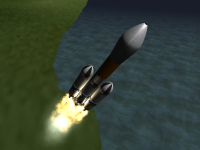


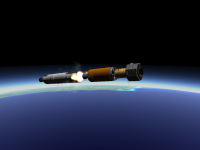
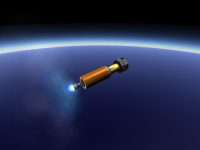


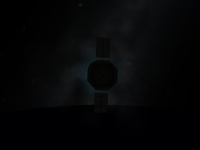
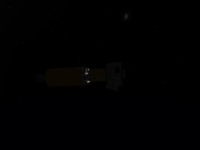

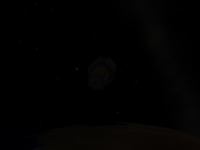
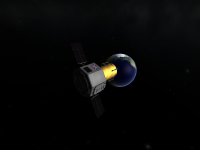
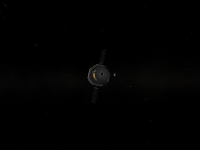
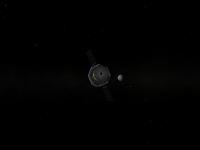

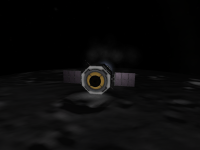
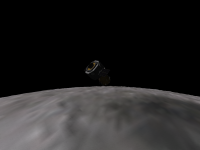


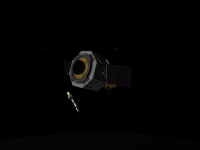



TLF-5 / LSE-2 was a manned lunar landing using the Delta Taxi Mk II (callsign "Deliverance") and the "Adventure" lander in conjunction with the Maclaurin A spaceplane (mission MTF-1). The multiple-launch architecture also involved a CDEDS, and made use of the Legendre Space Station in LEO at 400km/28.6°, as well as the Lebesgue Propellant Depot in LLO.
This 'E-class' lunar mission followed the 'D-class' TLF-4 landing earlier in the year, and used the same Delta Taxi vehicle for the crew transit between the Earth and Moon, it having been parked at Legendre in the meantime. The E mission differs in having a longer surface stay time due to the improved life-support systems of the lander. Another aspect was the targeted nature of the landing, the touchdown region having been chosen in Mare Orientale.

CONOPS diagram for this E-class lunar landing mission.
The first launch of the campaign, on the 28th of August 1966, was Leibnitz DE12, carrying the single-stage reusable lander, callsign Adventure, to LLO to dock with Lebesgue Propellant Depot. The lander, which can support a single astronaut for about four days, has a total ΔV capacity of 4800m/s; however, to fit within the TLI throw mass of the Leibnitz-Centaur launch vehicle, it was launched with only a partial propellant load giving about half that capability. This was more than enough to brake into LLO and dock with Lebesgue, where its tanks were filled up for the landing from the stock already present there.
The Leibnitz DE12 launch vehicle incorporates a few improvements versus the ’DE10 used to launch Frontier for the D mission; the boosters now use RS27 engines while the upper stage has an RL10A-3-3A for increased thrust.
Maclaurin A, a six-seat spaceplane with about 500m/s of orbital manœuvring capability from its RL10A-3-3A insertion engine plus 179m/s of peroxide RCS, launched for MTF-1 at 0602Z on December 16th 1966, atop the Galvani CH2 booster. This launch vehicle was broadly the same as the ’CH1 which launched the test flight (MPF-1); the main difference was in the spaceplane as Maclaurin's RCS had been upgraded for a few seconds' extra Isp. The launch had initially been scheduled for the 3rd of that month, but an ignition failure of one of the RS27 booster engines scrubbed that launch attempt. Fortunately all went well second time around.
The flight crew of the Maclaurin were Peter Chapman (1st pilot, who also flew the test flight) and Virginia Perez (2nd pilot); in the passenger cabin along with Rebecca Reid (who was to perform the lunar mission) were scientists Martha Bennett and Yefim Obolensky, on their way to make use of Legendre's new Laboratory Module. Virginia was on only her second spaceflight, having previously piloted NTF-12 for LPF-1a, while this was Peter's fifth. Rebecca was also flying for the fifth time, having been involved in several test flights of lunar hardware as well as performing the B-class TLF-2 mission back in 1964.
The spaceplane docked to the for'ard port of Legendre at T+11h34m, with cryo propellant still in the tanks. The combined mass of the Station and all visiting vehicles was just over 50 tons!
CDEDS 5 was launched by Euler Ax19 on December 18th. The Euler Ax is a further upgrade to our Euler heavy-lift launch vehicle, using lighter-weight tankage for both stages. The CDEDS broadly resembles the #4 used on TLF-4.
A nominal launch put the Eulerian upper stage into LEO with a 4’ relative inclination to the Legendre Space Station. After 4½ hours of phasing orbits and manœuvres, and topping-up of the CDEDS from the Eulerian's margins to cover boil-off, the latter was discarded and the CDEDS docked with Deliverance, the Delta Taxi Mk II piloted by Rebecca Reid.
At 1153Z on the 18th of December, Rebecca Reid, piloting the TLF-5 stack of Delta Taxi Mark II Deliverance and CDEDS 5, commenced the translunar injection burn, firing the RL10A-3-3A engine of the CDEDS for 6 minutes and 20 seconds to supply 3,141m/s of ΔV at an acceleration ranging from 0.6g to 1¼g. The vessels were undocked at 1200Z after the completion of the burn; the CDEDS was left on a lunar impact trajectory while the Delta Taxi used its RCS to properly position the periselene.
With an apogee of 717Mm, the Taxi's lunar transfer was somewhat expedited, with the lunar sphere of influence being reached at 0950Z on the 20th (46 hours after departure from LEO) and only a further 12½ hours' descent to the 82km periselene. This faster transfer meant a slightly greater LOI burn was required, a 940m/s manœuvre lasting 1½ minutes being performed at 2226Z to brake the vessel into 513×82km lunar orbit. A further 102m/s at 0036Z on December the 21st completed the rendezvous with Lebesgue Propellant Depot, and four minutes later the Taxi was safely docked and taking on supplies.
After waiting nearly two hours for the Moon to rotate a little (placing the landing site at the southeast limits of Mare Orientale under the Depot's orbit), at 0228Z Rebecca undocked the lander Adventure from Lebesgue Depot to begin the journey down to the lunar surface. At 0310Z, just as Earth was rising, a 17m/s burn lowered the lander's orbit to 100×25km. A further 50m/s at 0357Z took the craft sub-orbital, on a 31×-100km trajectory.
The final descent burn began at 0403Z; at 0412Z Adventure throttled down for terminal descent from an altitude of 9km, to touch down at 0415Z at 28°54’S 85°01’W. The landing used 2,177m/s of delta-V, leaving 2,377m/s for the ascent.
With the ship safely landed, Rebecca Reid climbed down the ladder to walk on the lunar surface, plant a flag, collect rock samples — all the usual stuff.
On December 23rd at 2237Z, having spent two days and 18 hours on the Moon, Adventure lifted off as it passed under Lebesgue's orbital track. The 101×13km orbit (with 11” relative inclination to the Depot) was reached at 2242Z, with 48 seconds (502m/s) of residuals, meaning that the ascent used just 1,875m/s. A 30m/s burn at 2325Z raised the orbit to 135×98km and yielded a rendezvous at 0125Z on the 24th. Rebecca matched velocities with a 250 metre separation, then waited until 0205Z for the sun to rise allowing a visual docking at 0210Z.
After undocking from Lebesgue, Deliverance made an 809m/s TEI at 2220Z on December 24th. At the completion of this burn, the Taxi was on course for a 148km perigee at the end of its 4½-day transfer. The trajectory had been carefully calculated to arrive with a suitable phase angle to Legendre Space Station.
The Moon's SoI was exited at 1658Z on December 25th, and after the long fall back into Earth's gravity well, the ERPS was fired for 170 seconds at 1128Z on the 29th to deliver 3,043m/s of ΔV (at up to 3.1g) and place the Delta Taxi Mk II in a 491×147km orbit, with a 29” relative inclination to Legendre.
Further burns of 70m/s at 1215Z and 44m/s at 1317Z brought Deliverance to a holding position 34m from the Station at 1322Z. After waiting for the sun to rise, docking was performed at 1344Z, with 64m/s of ΔV remaining in the Taxi's tanks. Rebecca Reid then waited at the station for a day and a half.
All five astronauts — Peter, Virginia, Rebecca, Yefim and Martha — were back aboard Maclaurin at 0124Z on December 31st, along with Rebecca's moon rocks and the fruits of a fortnight's work in the Legendre Lab by the two scientists. The spaceplane undocked from the Station and began orbit lowering with a 74m/s RCS burn lasting from 0129Z to 0134Z and reaching 398×180km. This was further lowered at 0345Z when another 24m/s took the Maclaurin to 323×180km, followed by the 39m/s deorbit burn at 0429Z. Three minutes later this was completed and the spaceplane's orbit was 323×50km.
20 minutes after that, at 0452Z, the solar arrays and communications antenna were retracted in preparation for the re-entry, which began at 0458Z, with the Kármán line crossing following at 0502Z. Aerodynamic lift was enough to halt the spaceplane's descent five minutes later at 73km altitude, after which velocity and altitude continued to be gradually bled away. The Space Centre was overflown at 0526Z, at a height of 21km and a Mach number of 1.4; two minutes later the Maclaurin, now subsonic, turned to enter the circuit.
Sadly, much as on the test flight, the final approach was slightly misjudged and Maclaurin touched down in the runway underrun, about 2km short of the threshold, fortunately without damage. As the spaceplane rolled to a stop, the MTF-1/TLF-5/LSE-2 mission combo was completed, just before the end of 1966.
Through the improvements incorporated in the lander Adventure and the Maclaurin spaceplane, lunar landing missions have been made thoroughly routine; at least one repeat performance is planned for 1967, after which I intend to work on upgrading the lunar orbit infrastructure into a proper Station (provisionally named Lacroix) and developing vehicles to send more than one astronaut at a time on a lunar mission.
Elsewhere in the Solar System, Copernicus 14 is on its way to Mars to radar-map the Red Planet's surface, while Fahrenheit 4 is taking landers for Mars and both its moons; Copernicus 15 is heading for Vesta orbit; and a new Habitation and Docking Module is being prepared for launch to Legendre where it will enable the Station to support two Maclaurins and up to ten crew members simultaneously. The Space Program's future is, as always, bright with possibility.